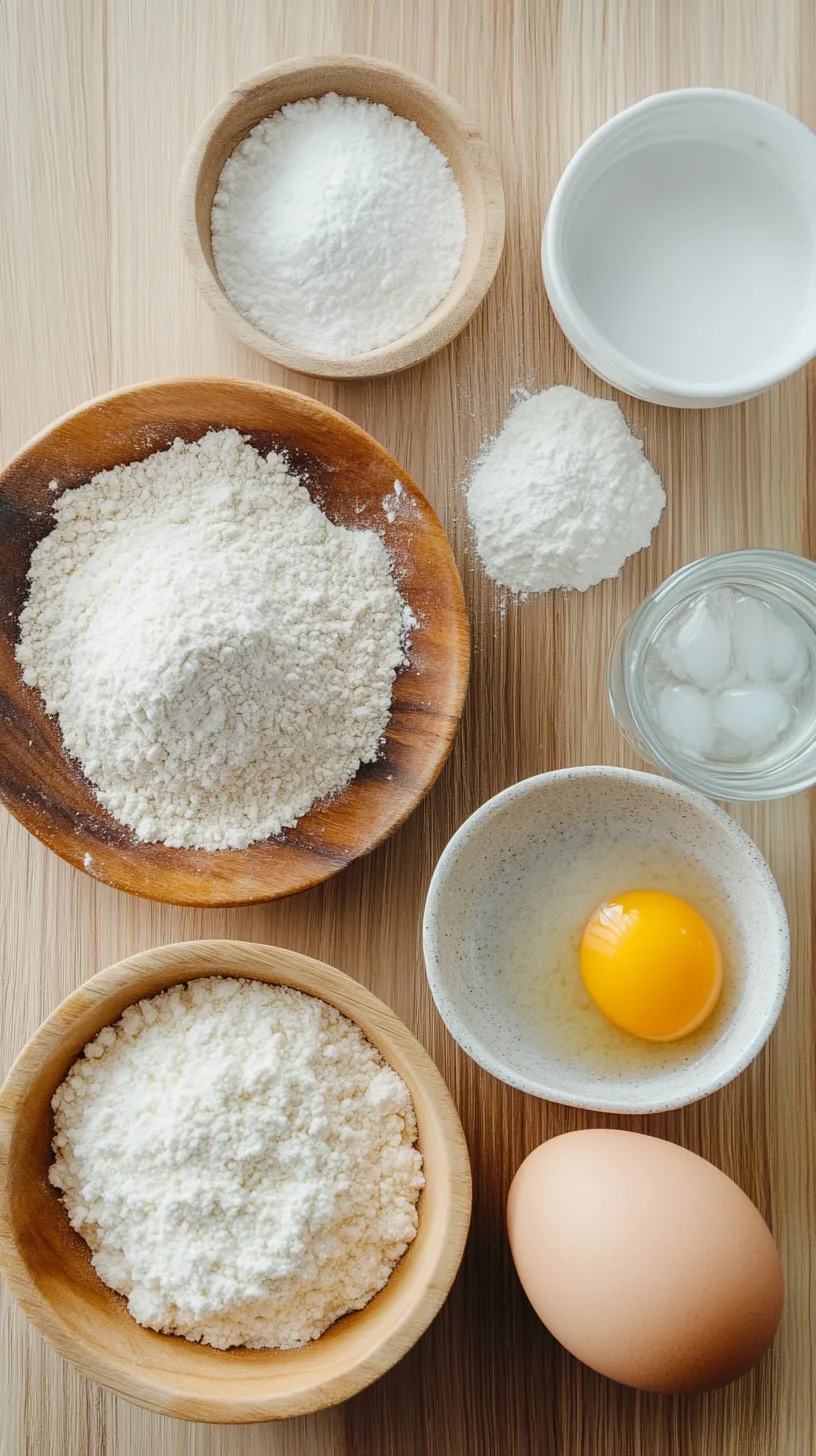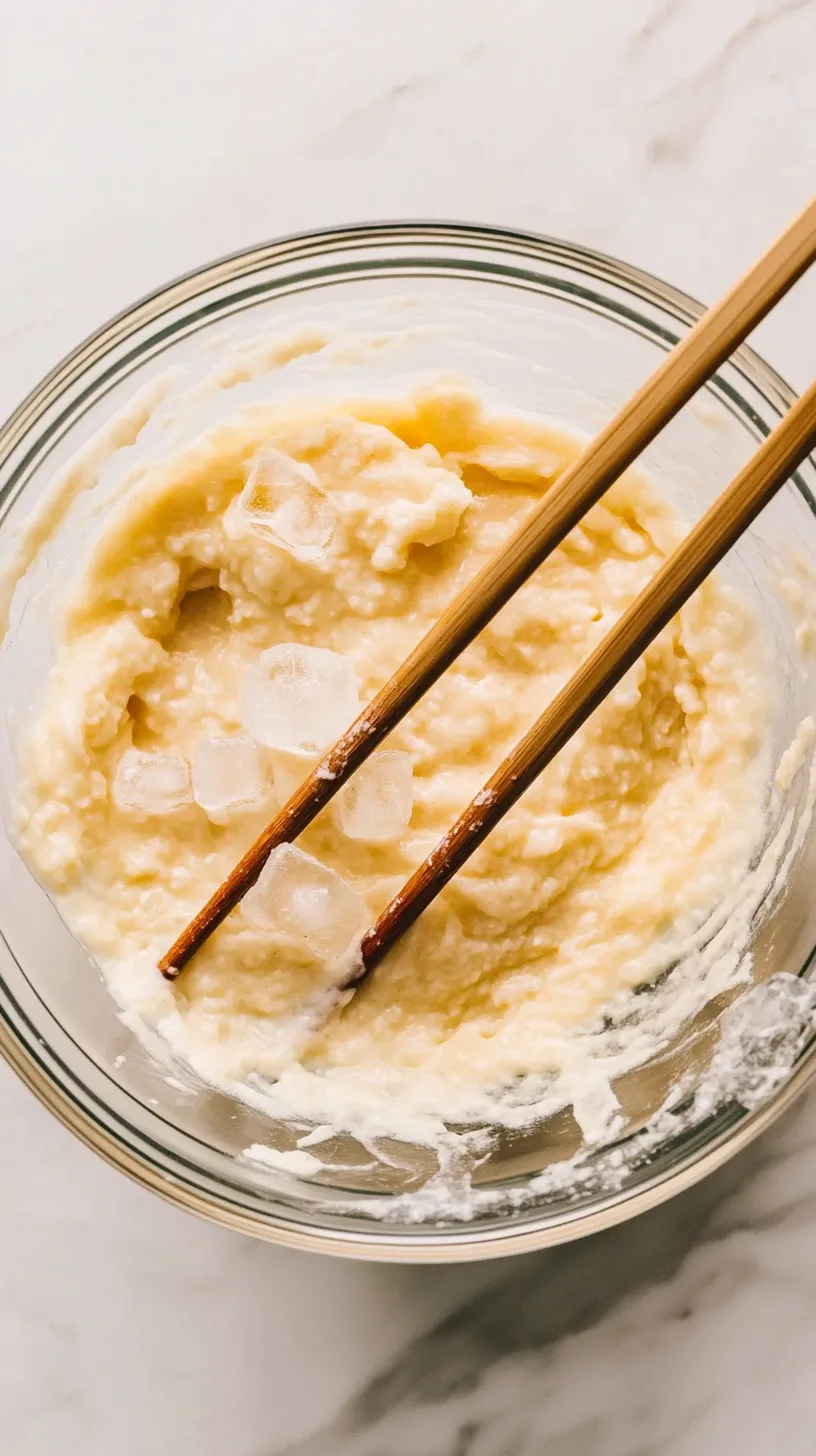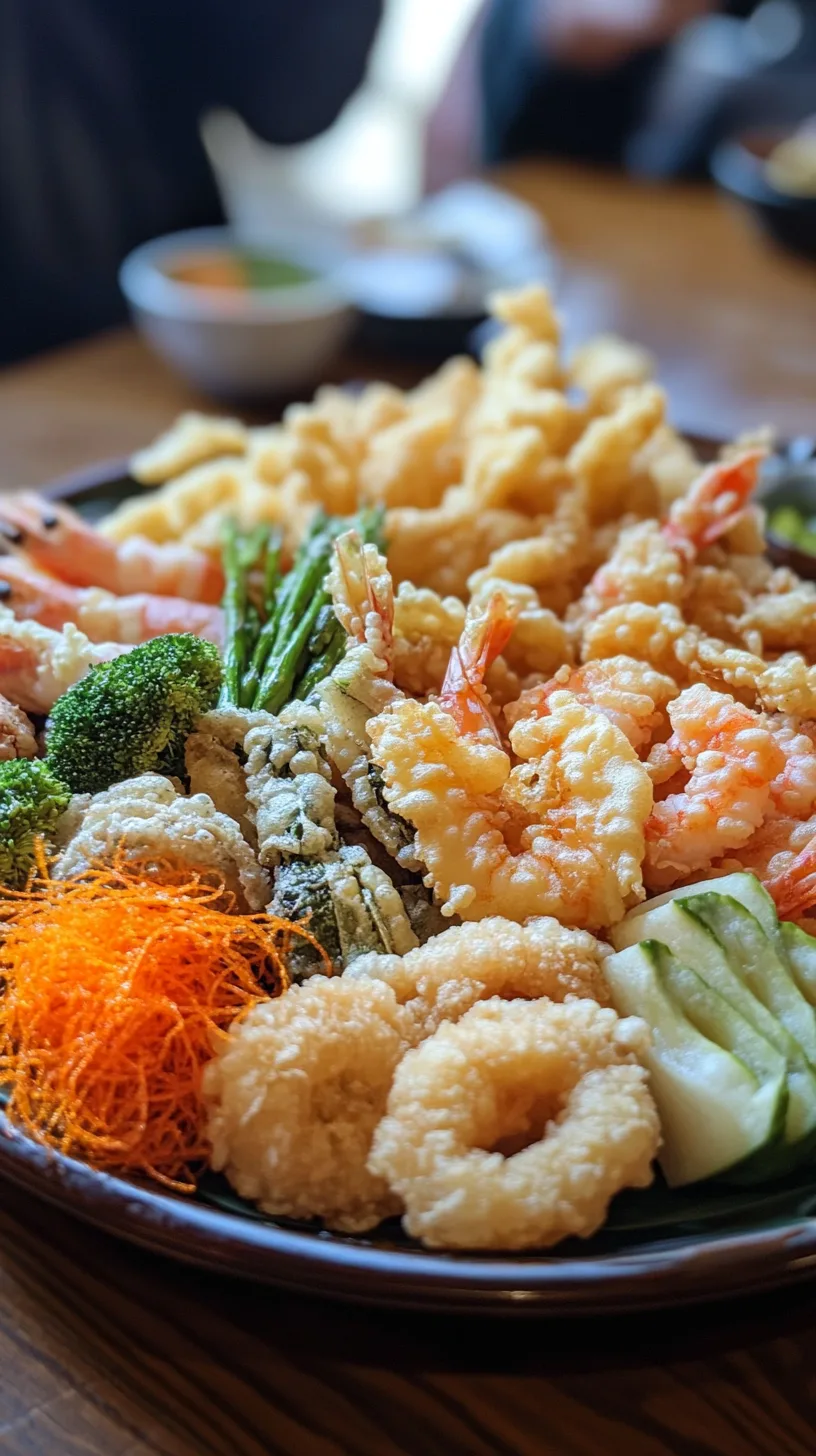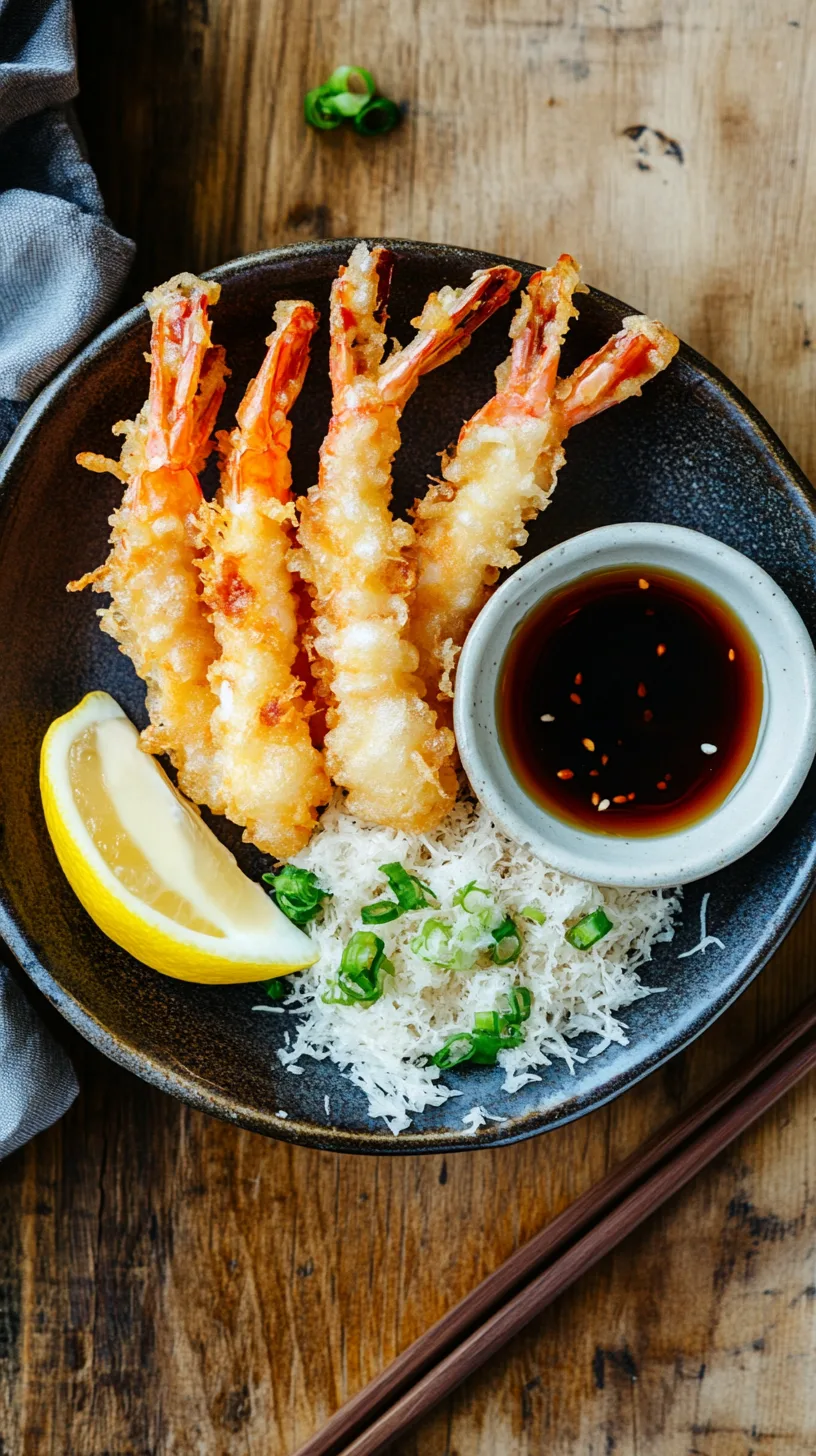Forget Soggy! Get Restaurant-Crispy Tempura Batter Every Time
Ever bitten into tempura that was more blah than bam?
We get it.
That sad, soggy coating is a real disappointment.
So many recipes promise that light, crispy, almost ethereal crunch, but few deliver, it can feel hopeless.
We’re going to fix that. This isn’t just a tempura batter recipe; it’s the tempura batter recipe you’ll use forever.
What is Tempura Batter?
Tempura, it seems like it is a long time staple of Japan.
It isn’t!
It was actually introduced to Japan by Portuguese missionaries in the 16th century.
Crazy right?
The name even comes from the Latin word “tempora,” which refers to times of fasting.
Over time, the Japanese refined the dish into the art form we know and love today.
It’s all about that contrast: a delicate, crispy shell encasing perfectly cooked ingredients.
Essential Ingredients for Perfect Homemade Tempura Batter

Getting that perfect crunch starts with the right ingredients. It ain’t rocket science, just a bit of know how. Here’s the breakdown:
Flour
We use a mix. All-purpose flour provides structure, the back bone to our batter. Cake flour makes things lighter. Some folks even swear by only cake flour, it is your kitchen, test and learn.
Starch
Cornstarch is our go to choice, it provides a whole bunch of crispiness. Rice flour is another great choice, and potato starch works in a pinch. Each gives a slightly different texture, so feel free to experiment!
Egg Yolk
A single, very cold egg yolk, adds richness and helps bind the batter. That little bit of fat is essential for flavor.
Ice Water
This is non-negotiable. We’re talking ice-cold, with actual ice cubes floating in it. The cold prevents gluten development, which is the enemy of crispiness.
Baking Powder
Just a touch, it gives the batter extra lift, a little boost.
Rice Vinegar
A splash of magic! Its acidity chills out the gluten, and boosts the crispness factor.
Achieving the perfect tempura batter relies on precise measurements; learn how to measure dry ingredients like a pro for consistent results.
Step-by-Step Guide To Creating the Ideal Tempura Batter
Follow these steps closely. Remember, the key is gentle handling and cold temperatures.
First, chill your mixing bowl, flours, and starches in the freezer. Do that for at least 15 minutes.
Get some ice water, and I mean ice water. Fill that measuring cup with water and lots of ice.
Get your chilled bowl. Gently whisk together your all-purpose flour, cornstarch, rice flour and baking powder. Little lumps? No big deal.

Make a well, a nice indent, in the center of your dry stuff. Drop in that very cold egg yolk.
Pour in the ice water (ice cubes and all!). A splash of chilled rice vinegar.
Mix it up, but gently. Use a whisk or chopsticks and a folding motion. Don’t go crazy! Stop mixing when things are just combined. Lumpy batter is good batter.

If you are patient, let that batter rest in the fridge. Fifteen to thirty minutes is cool. Gluten relaxes, starch granules do their thing. You can skip this, but resting does help.
Oil is hot, time to cook. Dip your favorites into that batter and straight into that hot oil, dont overcrowd the pan, a few items is best. Fry til it’s that gorgeous golden brown, couple minutes.
The same principles of lightness apply when making dishes like this crepe batter recipe.
Secrets to Achieving Ultra-Crispy Tempura
Achieving truly crispy tempura is about mastering a few key techniques.
While the recipe is crucial, these tips are what will really elevate your tempura from good to exceptional.
Think of them as the foundational principles for tempura success.
Precise Temperature Control
Temperature is absolutely paramount.
Maintaining a consistent oil temperature of 350°F (175°C) is essential for achieving that signature crispy texture.
Equally important is using ice-cold ingredients and batter.
This temperature differential is what creates steam during frying, resulting in a light and airy, rather than dense, coating. Using a thermometer to monitor your oil temperature is not just recommended, it’s necessary for consistent results.
Gentle Mixing is Key
Overmixing tempura batter is a common pitfall.
Excessive mixing develops gluten, which leads to a tougher, less delicate tempura.
The goal is to combine the wet and dry ingredients just until moistened.
A lumpy batter is perfectly acceptable, and in fact, desirable. It’s a sign that you haven’t overworked the batter and gluten development is minimized.
Fry in Manageable Batches
It can be tempting to fry a large quantity of tempura at once, especially when you’re eager to eat.
However, overcrowding the pot will significantly lower the oil temperature.
This temperature drop results in tempura that absorbs too much oil and becomes soggy instead of crispy.
Frying in smaller batches ensures the oil temperature remains stable, allowing each piece to cook properly and achieve optimal crispness.
Select the Right Frying Oil
The type of oil you use plays a role in the final outcome.
You need an oil with a high smoke point to withstand the frying temperatures without breaking down or imparting off-flavors.
Neutral-tasting oils like vegetable oil, canola oil, or peanut oil are all excellent choices for tempura.
By focusing on these core principles – temperature control, gentle mixing, batch frying, and oil selection – you’ll be well on your way to creating consistently crispy and delicious tempura at home.
Just like achieving the perfect rise in baking, how to measure baking ingredients correctly is crucial for tempura’s light texture.
Troubleshooting And Avoiding Common Tempura Pitfalls
Even with the best recipe, sometimes things go wrong. Here’s how to fix common problems:
Soggy Tempura
The oil wasn’t hot enough, or you overcrowded the pot, let things warm up and go slower next time.
Thick, Doughy Batter
You probably overmixed, go easy next batch.
Or maybe you didn’t use enough liquid.
Batter Not Sticking
Make sure your ingredients are dry before dipping them in the batter.
A light dusting of flour before battering can also help.
Maintaining the correct oil temperature is paramount; our guide on deep-frying techniques provides essential tips that directly apply to tempura.
What Can You Fry Using Tempura Batter? Endless Crispy Possibilities!

Okay, so you’ve got this amazing tempura batter. Now what do you do with it? The possibilities are practically endless! Tempura isn’t just for shrimp, you know. Get creative! Here are some of our favorite things to tempura-fy:
- Seafood Classics: Shrimp (ebi tempura is a must-try!), prawns, scallops, white fish fillets (like cod or halibut), calamari rings.
- Veggies Galore: Asparagus, broccoli florets, bell pepper strips, eggplant slices, green beans, kabocha squash, lotus root, mushrooms (shiitake, maitake, enoki), onion rings, sweet potato slices, zucchini sticks.
- Fun & Unexpected: Shiso leaves (crispy and fragrant!), okra, baby corn, nori (seaweed) strips, even avocado slices (fry them briefly!).
- Fruity Surprise: Apple slices, banana slices (for dessert tempura!).
- Chicken Tempura: Yes, you can tempura chicken too! Cut chicken breast into bite-sized pieces.
- Egg Tempura: Soft boiled egg tempura is a delicacy!
- Tempura Udon/Soba: Top your noodles with freshly fried tempura for a complete Japanese meal.
- Tempura Donburi: Serve tempura over a bowl of rice with a savory tentsuyu sauce for a satisfying tempura rice bowl.
- Tempura Hand Rolls: Use crispy tempura shrimp or veggies in sushi hand rolls for extra crunch.
- Tempura Tacos: Fusion fun! Crispy tempura shrimp or fish in tacos with slaw and spicy mayo.
- Tempura Salad: Top a fresh salad with tempura vegetables for a textural and flavorful contrast.
- Tempura Appetizer Platter: Create a platter with a variety of tempura veggies and seafood for parties.
- Tempura Skewers: Thread veggies and seafood onto skewers, tempura-fy them, and serve as fun appetizers.
- Tempura Pizza Topping: Get wild and top your pizza with tempura veggies or shrimp!
- Tempura Burger Topping: Crispy onion rings or tempura mushrooms on a burger? Yes, please!
- Tempura Ice Cream: Dessert tempura at its finest! Quickly fry a scoop of ice cream wrapped in pound cake or sponge cake for a mind-blowing treat.
- Tempura French Toast: Savory-sweet breakfast tempura? Dip French toast in tempura batter and fry for a unique brunch dish.
- Tempura Pickles: Deep-fried pickles, tempura style! Serve with a spicy dipping sauce.
- Tempura Avocado Fries: Creamy avocado inside a crispy tempura shell, served with a dipping sauce.
- Tempura Cheese Curds: Wisconsin cheese curds get a Japanese tempura makeover.
- Tempura Oreos: State fair food, elevated! Deep-fried Oreos in tempura batter for a decadent dessert.
Seriously, once you master this batter, your kitchen adventures are gonna get a whole lot crispier. Don’t be afraid to experiment and tempura-fy anything your heart desires!
Looking for other asian inspired crispy food? Check out our Chicken Katsu Recipe
Delicious Tempura Batter Variations
Once you’ve mastered the basic batter, have some fun with these variations:
Gluten-Free Tempura
Use a gluten-free flour blend. Make sure it has xanthan gum for binding. Rice flour as the main component works well.
Spicy Tempura
Add a pinch of cayenne pepper or a dash of your favorite hot sauce to the batter.
Herb Tempura
Mix in some finely chopped fresh herbs. Parsley, chives, or cilantro are good.
Beer Tempura
Substitute the ice water with ice-cold beer, a lighter crisp is the result.
Perfect Pairings: What to Serve with Your Tempura

Tempura is delicious on its own, for sure, but it’s even better with the right accompaniments:
Tentsuyu Dipping Sauce
This classic Japanese sauce is made with dashi, soy sauce, mirin, and grated daikon radish.
Plain Soy Sauce
A simple, always-good option.
Lemon Wedges
A squeeze of fresh lemon juice brightens up the flavors.
Grated Ginger
A refreshing palate cleanser.
Japanese Pickles
Their acidity cuts through the richness of the fried food.
Storing and Reheating Leftover Tempura (and Batter)
Honestly, tempura is best enjoyed fresh. It doesn’t reheat super well. But, if you have leftovers:
Batter
You can store leftover batter in the refrigerator for up to a day. Stir it gently before using.
Cooked Tempura
Store in an airtight container in the fridge. To reheat, use an oven or toaster oven (not a microwave!) to try to regain some crispness.
Tempura Batter Recipe
Print
Ultra-Crispy Classic Tempura Batter (with a Secret Ingredient!)
- Prep Time: 10 minutes
- Chill Time: 15 minutes (minimum, up to 1 hour)
- Cook Time: 2-3 minutes per batch (depending on what you’re frying)
- Total Time: 27 – 73 Minutes
- Yield: Approximately 2 cups of batter (enough for about 1–1.5 lbs of ingredients) 1x
- Category: Appetizer, Side Dish, Main Course (depending on what’s battered)
- Method: mixing, frying
- Cuisine: Japanese
Description
Forget soggy tempura! This recipe delivers that signature light, airy, and incredibly crispy coating every time. We’ve combined the best techniques from authentic Japanese recipes and added a touch of magic for extra crunch. Get ready to elevate your home-cooked tempura to restaurant quality.
Equipment:
- Large Mixing Bowl (preferably metal, for better cold retention)
- Whisk (or chopsticks)
- Measuring Cups and Spoons
- Deep Fryer or Large, Heavy-Bottomed Pot
- Thermometer (candy/deep-fry thermometer)
- Slotted Spoon or Spider Strainer
Ingredients
- 1/2 cup All-Purpose Flour, chilled
- 1/4 cup Cornstarch, chilled
- 1/4 cup Rice Flour, chilled
- 1 large Egg Yolk, very cold
- 1 cup Ice Water (see Notes)
- 1/4 teaspoon Baking Powder
- 1 tablespoon Rice Vinegar, chilled (This is the secret ingredient!)
Instructions
- Chill Everything: Before you start, place your mixing bowl, flour, cornstarch, and rice flour in the freezer for at least 15 minutes. This extreme cold is key to crispy tempura.
- Prepare Ice Water: Fill a measuring cup with 1 cup of water. Add several ice cubes to make it ice-cold. You’ll use this water directly, ice and all, in the batter.
- Combine Dry Ingredients: In your chilled mixing bowl, gently whisk together the all-purpose flour, cornstarch, rice flour, and baking powder. Don’t overmix; a few lumps are fine.
- Add Egg Yolk: Create a small well in the center of the dry ingredients. Add the very cold egg yolk.
- Add Ice Water (and Vinegar): Pour the ice water (including the ice cubes!) into the bowl. Add the chilled rice vinegar.
- Mix Gently: Using a whisk or chopsticks, gently mix the ingredients. Use a folding motion rather than vigorous whisking. Stop mixing as soon as the ingredients are just combined. The batter should be lumpy and uneven – this is perfect. Do not overmix! Overmixing develops gluten, leading to a tough, chewy batter.
- Rest (Optional but Recommended): For best results, let the batter rest in the refrigerator for 15-30 minutes. This allows the gluten to relax further and the starch granules to absorb more moisture. You can skip this step if you’re short on time, but resting improves the texture.
- Fry Immediately: Once your oil is heated (340-350°F / 170-175°C), dip your prepared vegetables or seafood into the batter, ensuring they are evenly coated, and immediately place them in the hot oil. Fry in small batches to avoid overcrowding the pot, which lowers the oil temperature. Cook until golden brown and crispy, about 2-3 minutes per batch.
- Remove Cooked Tempura, once finished cooking remove using a slotted spoon or spider and set on a wire rack.
Notes
- Ice Water Importance: Using ice water (literally with ice cubes in it) is crucial. The cold temperature inhibits gluten development, resulting in a lighter, crispier batter.
- The Secret Ingredient (Rice Vinegar): The addition of rice vinegar is the unique element. While some recipes use vodka for a similar effect, rice vinegar adds a subtle tang and, more importantly, further inhibits gluten formation due to its acidity. This results in an even crispier, more delicate crust. It also subtly complements the flavors of traditional Japanese cuisine. This provides that slight edge that people will remember.
- Don’t Overmix!: This is the most common mistake. A lumpy batter is a good batter for tempura.
- Batter Consistency: The batter should be thin, similar to the consistency of heavy cream. If it seems too thick, add a tiny bit more ice water, one tablespoon at a time.
- Frying Oil: Use an oil with a high smoke point, such as vegetable oil, canola oil, or peanut oil.
- Oil temperature is important. Use a thermometer!
Nutrition
- Serving Size: per 1/4 cup serving of batter – approximate
- Calories: 150
- Sugar: 0g
- Sodium: 20mg
- Fat: 2g
- Saturated Fat: 0.5g
- Carbohydrates: 28g
- Fiber: 1g
- Protein: 3g
- Cholesterol: 50mg
Tempura FAQs: Your Questions Answered
Let’s tackle some common questions:
You can, but it’s best made just before frying. If you must, refrigerate it and stir gently before using.
Check your oil temperature, did you overcrowd, and was your batter too warm or over mixed.
No, it will make the batter too thick and cakey.
A neutral-flavored oil with a high smoke point, like vegetable, canola, or peanut oil.
Yes, you can! Use additional ice water or a flax egg (1 tablespoon ground flaxseed meal mixed with 3 tablespoons water) as a substitute.
Make sure to pat dry all items before dipping.
Sure you can.
Why You’ll Love this Tempura Batter
It is easy. It makes super crispy tempura, what is there not to love?
Nutritional Insights (per 1/4 cup serving of batter – approximate):This is just a ballpark. The actual numbers will vary, depending on ingredients.
- Calories: 150
- Fat: 2g
- Saturated Fat: 0.5g
- Cholesterol: 50mg
- Sodium: 20mg
- Carbohydrates: 28g
- Fiber: 1g
- Sugar: 0g
- Protein: 3g
Ingredient Alternatives
Cornstarch
Can’t find it? Use potato starch or more rice flour.
Rice Flour
If you’re out, just use more all-purpose flour or a bit of cornstarch.
Rice Vinegar
No worries, use a tiny splash of white vinegar, or skip it altogether.
Egg Yolk
One tablespoon of flaxmeal and three tablespoons of water work well.
The Final Bite
We’ve shared our secrets, and now it’s your turn to create some tempura magic.
With a little practice, you’ll be whipping up batches of perfectly crispy, golden-brown goodness that will impress even the toughest critics.
Remember, keep it cold, keep it gentle, and have fun!
This culinary journey, crafted from my 20 years in professional kitchens (including running the show as an Executive Chef!), is my way to assist.
Want more kitchen wins like this, straight from a pro?
Sign up for the Simply Delicious Newsletter by Edible Exposure Media, its my passion project.
You’ll get more exclusive recipes, insider tips, and culinary inspiration delivered right to your inbox. Happy frying! – Ryan Yates.
About the Author
Ryan Yates is a culinary expert with over 20 years of experience in commercial kitchens. As a working executive chef, he has a passion for creating delicious, accessible recipes that bring joy to home cooks everywhere. Ryan believes in the magic of simple ingredients and loves sharing his knowledge to help others find happiness in cooking.


